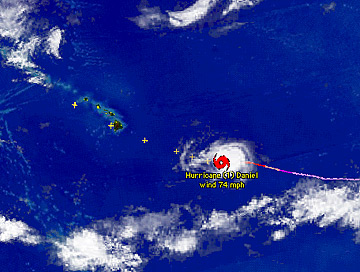Weakening Hurricane Daniel still a concern for Big Isle
Residents are warned to pay attention as the storm nears Hawaii
Hurricane Daniel is losing steam as it enters colder waters, but it could still wallop the Big Island with winds of up to 50 mph by Friday.
And winds could be even faster and stronger on the Kona side, with officials now warning residents against complacency.
"I don't want (residents) taking it with a yawn," said Troy Kindred, head of Hawaii County Civil Defense. "I would prefer not to have a tropical storm pass over my island."
Hurricane Daniel, the first major storm of the season to cross into the Central Pacific, is expected to decline to a tropical storm by the time it reaches the Big Island on Friday. If winds of 50 mph hit Hilo, the same winds flowing downhill on the Kona side could be 25 percent faster and stronger, Kindred said.
And as Daniel gets closer, some residents are beginning to ask about hurricane clips, metal straps required on new homes but absent from older ones, Kindred said.
At 5 p.m. yesterday, Daniel was about 875 miles east-southeast of Hilo and about 1,080 miles east-southeast of Honolulu, according to the National Weather Service.
Early in the day, forecaster Norman Hiu at the agency said Daniel had sustained wind of nearly 90 mph with higher gusts, but by the 5 p.m. update that number declined to 75 mph, just above the 73 mph dividing line between a hurricane and a tropical storm.
Citizen reaction on the Big Island was mixed. Hawaii County Civil Defense took about 20 calls from residents yesterday, Kindred said.
But an assistant manager at the downtown Hilo Longs Drug said there was no special activity from customers.
Kindred was appointed head of Big Island Civil Defense in 2003 but was sent to Iraq with the National Guard shortly afterward. His job requirements in both cases were the same: coordinating responses to threats.
Since he returned to the Big Island late last year, he has noticed residents have been sensitized to disasters because of Hurricane Katrina last year in New Orleans and the Indian Ocean tsunami of December 2004.
People are trying to make themselves more informed, he said.
Kindred also tried to make agencies better informed, meeting with federal, state, county and private agencies yesterday to urge them to review and update their disaster preparedness plans.
Also participating was Mayor Harry Kim, head of county Civil Defense for 24 years and still a deputy director of state Civil Defense by virtue of his office.
Daniel was moving at 14 mph yesterday morning but slowed to 9 mph by evening.
That illustrated part of the uncertainty of what an storm will do. The Weather Service prepared a geographic cone that widens the closer it gets to the Big Island.
The center line of the cone indicates the storm is still headed toward the island, but the width of the cones indicates it could pass either north or south of the island.
"Under the current projection it will be over the Big Island on Friday," said forecaster Hiu, "but that track is subject to change."
The Weather Service evening bulletin said hurricane-force winds extend outward up to 10 miles from the center of Daniel, and tropical storm-force winds extend outward up to 75 miles.
State Civil Defense officials are urging residents to make themselves "storm ready" in case Daniel hits the islands. Information on disaster preparedness is available in the Hawaiian Telcom and Paradise telephone directories.
A news release from state and county Civil Defense officials advises residents to have disaster kits that they can take to shelters, to stock up on nonperishable food and water in case utilities are not available in the wake of a storm and to have fresh batteries for portable radios.

COURTESY EARTHBROWSER.COM
HURRICANE CHECKLIST
American Red Cross officials recommend keeping a three-day emergency kit that can be used to weather a hurricane or other emergency at home, or taken to a Red Cross Evacuation shelter. It should include:
» Water: One gallon of water per person a day, in plastic containers.
» Food: At least a three-day supply of nonperishable food that needs no refrigeration, preparation, cooking and little or no water and is compact and lightweight, such as ready-to-eat canned meats, fruits and vegetables; canned juices; small amounts of salt, sugar, pepper; high-energy foods; food for infants or those with special diets; "comfort" foods.
» A first-aid kit: Twenty adhesive bandages, various sizes; one 5-by-9-inch sterile dressing; one conforming roller gauze bandage; two triangular bandages; two 3-by-3-inch sterile gauze pads; two 4-by-4-inch sterile gauze pads; one roll of 3-inch cohesive bandage; two germicidal hand wipes or waterless alcohol-based hand sanitizer; six antiseptic wipes; two pair large medical grade nonlatex gloves; 2-inch-wide adhesive tape; antibacterial ointment; a cold pack; small scissors; tweezers; CPR breathing barrier, such as a face shield; aspirin or nonaspirin pain reliever; anti-diarrhea medication; antacid; laxative; syrup of Ipecac and activated charcoal (for use if advised by the Poison Control Center).
» Tools and supplies: Mess kits, or paper cups, plates and plastic utensils; emergency preparedness manual (available from Red Cross); battery-operated radio and extra batteries; flashlight and extra batteries; cash or traveler's checks, change; nonelectric can opener, utility knife; toilet paper, towelettes; soap, liquid detergent; feminine supplies; personal hygiene items.
» Clothing and bedding: One change of clothing and footwear per person, including sturdy shoes or work boots; rain gear; blankets or sleeping bags.
» Special items: Baby formula, diapers, bottles, milk and medications; prescription medications, including heart and high-blood-pressure medication and insulin; denture supplies; contact lens supplies; extra eyeglasses.
» Entertainment: Quiet games, cards, toys and books.
Source: American Red Cross
|
|
Star-Bulletin reporter Gregg K. Kakesako contributed to this report.

